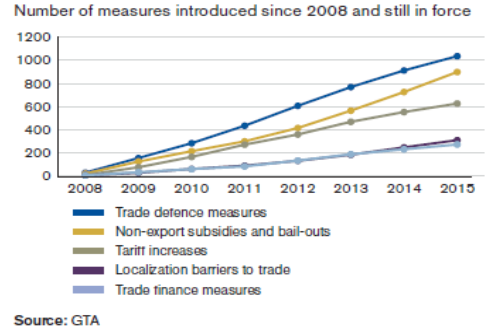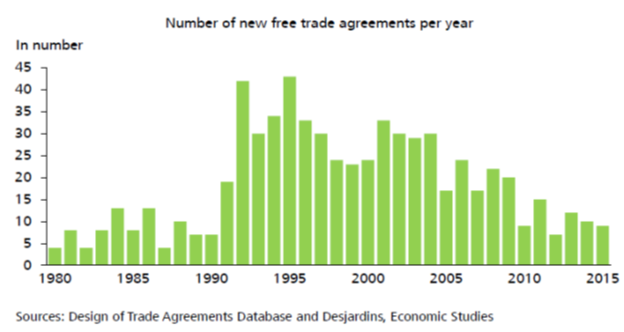What is Trade Protectionism?
Trade protectionism is defined as a nation, or sometimes a group of nations working in conjunction as a trade bloc, creating trade barriers with the specific goal of protecting its economy from the possible perils of international trading. This is the opposite of free trade in which a government allows its citizenry to purchase goods and services from other countries or to sell their goods and services to other markets without any governmental restrictions, interference, or hinderances. The objective of trade protectionism is to protect a nation’s vital economic interests such as its key industries, commodities, and employment of workers. Free trade, however, encourages a higher level of domestic consumption of goods and a more efficient use of resources, whether natural, human, or economic. Free trade also seeks to stimulate economic growth and wealth creation within a nation’s borders.
There are various methods of trade protectionism whose goal is to protect a nation’s economic well-being. These include:
Tariffs which are a tax on imports from other countries and foreign markets. Here, the government imposing the tariff is looking to restrict imports of foreign goods and services, protect its own industries and companies manufacturing such items and raise tax revenues. Tariffs could be specific in which there is a fixed tax rate or fee for each unit of a product or commodity brought into a nation. There are also ad valorem tariffs which are set as a proportion of the value of the imported product.
Quotas are a direct restriction on the number of certain goods, products, and commodities that may be permitted to be imported into a nation. This import quota is generally enforced by the issuance of import licenses to a certain group of persons or companies. There is also voluntary export restraint (VER) that acts as a trade quota imposed by an exporting nation. VERs can also come in the form of political pressure on a nation by another country in order to stop the export of goods or commodities.
Subsidies are government payments to domestic producers. This can come in the form of cash payments, low-to-no interest loans, tax breaks, and government ownership of common stock in domestic companies. Subsidies help domestic producers by having extra cash available for production of goods thereby lowering manufacturing costs and allowing these same companies to gain foreign markets.
Local content requirements may be imposed by a nation seeking to decrease imports by setting a manufacturing requirement in which a stated part or parts of a product must be made domestically. This occurs by having a percent of a product manufactured domestically or that in value terms, such as 85 percent of its value, must be made locally.
Administrative trade policies consist of bureaucratic rules, laws, and regulations designed to create serious difficulties for an importer of goods or commodities into a particular nation. Formal trade barriers can come in the form of onerous rules, regulations, administrative requirements, and paperwork to be completed. Informal trade barriers include the inspection of every product, good, and commodity entering a nation in order to check for disease or suspicious content. This can take time, effort, and may often severely damage the item being inspected. Administrative policies can also involve setting high-level health and safety standards and difficult-to-obtain import licenses for foreign producers.
Antidumping policies are enacted by a nation in order to prevent the selling of goods in a foreign market at a price far below their production costs in order to gain a substantial share of that nation’s market. Anti-dumping rules can also include regulations prohibiting the sale of goods, products, or commodities below its fair market value.
Exchange rate controls can be used to make a nation’s product cheaper abroad by lowering the value of its currency in the foreign exchange markets. The premise is that a nation can sell its currency in foreign exchange markets to the point where its loses value against other currencies. This will cause the price of imports to rise while lowering the cost of its exports. This will help a nation, whether developed or developing, increase the opportunity to sell its products and goods in foreign markets.
Why Trade Protectionism occurs
There are numerous reasons why a nation would adopt a trade protectionist policy. They are generally regarded as government intervention since it is a government that has control over its borders and the flow of goods, products, and commodities in and out of a country. They include:
Protecting jobs and industries is a political argument for trade protectionism from the viewpoint that protecting worker’s livelihood and the industries and the firms that employ them are vital to a nation’s economic growth and well-being. The premise is that without trade protectionism a nation could lose long-established industries and companies that first made a product in a particular nation. This will eventually result in the loss of jobs, rising unemployment, and eventual decrease of a nation’s gross domestic product (GDP).
National security is used for trade protectionist policies since the industries involved include defense-related companies, high-tech firms, and food producers. The argument here is that industries such as aerospace, advanced electronics, and semi-conductors are vital components of national defense policy and that relying on foreign manufacturers would seriously affect a nation’s defense in time of war. By having manufacturing for defense items protected from foreign competition, trade protectionism is necessary for a nation’s existence.
Protecting consumers is an argument used by policymakers to protect consumers from unsafe imported products. Consumer advocates, domestic manufacturers, and certain policymakers claim that foreign-made goods may fail to follow requirements for product safety in the manufacturing and distribution process. This could result in serious illness, unsafe products, and even possibly death of the consumer. Domestic manufacturers argue that if they must follow government-imposed safety and production requirements then foreign producers must also do so.
The infant industry argument was first put forth by Alexander Hamilton in 1792. This idea states that new manufacturers have an extremely difficult time competing against well-established, well-funded, extremely profitable companies in developed countries. New manufacturers in developing nations may not have the economic and financial resources, as well as the technology, physical equipment, and research and development expertise to compete against older, established firms. In order that infant industries and new companies gain market-share and a competitive edge against well-established firms, governments must put into place short-term support mechanisms for these infant industries until they have reached a level so they can compete with foreign companies. It can also be argued that a developing nation in attempting to diversify its economy, must protect its infant industries. Government intervention of an infant industry may come in the form of tariffs, subsidies, administrative trade policies, or quotas.

The top five protectionist measures
Effects of Trade Protectionism
Despite the intent of certain economists and policymakers, trade protectionism has certain long and short-term effects on a nation’s macro-economy and often the global economy. These effects include:
Consumers’ limited choice and pay more for goods and services. A key effect of trade protectionism is that consumers will have a limited choice of products and goods since there may be quotas on how much may be imported. Due to these quotas, consumers will have a very limited choice as to the quantity, quality, and type of product that would otherwise be available to them without trade protectionism. Protectionist policies that intended to safeguard industries, companies, and jobs actually mean that consumers are limited in the availability of products and goods and may have to settle for poor quality instead. Another problem that consumers will face is that they will have to pay more for the limited quantity of goods and products, thus causing inflation to possibly greatly increase. If consumers have a limited choice, must settle for lower quality, and pay more for a particular product, then they may either pay that amount, purchase less of that product, or not make a purchase at all. Domestic firms may also be hurt financially since they may have to purchase parts to make their products and then pass the increased cost on to the consumer. Overall, global competition is a key factor in keeping the price of numerous goods and products down and give consumers the ability to spend.
Infant industries may never grow up due to government trade protection policies. The key questions are: When will an infant industry no longer need protection from its home government? When will it be regarded as a mature company that has a comparative advantage against foreign companies and in overseas markets? A nation can use the policy of protecting its infant industry, but for how long is a key concern. The protection of an infant industry may actually end up costing a government significant amount of money and financial resources in order to protect its infant industry. This may actually promote inefficiencies by the infant industry and have no incentive to make efficient, intelligent, long-term investments by borrowing funds or issuing common stock from the domestic international capital markets. This type of protectionism may hinder the growing pains and maturation process that are vital for an infant industry to experience in the short and long-term if it is to be successful and competitive in global markets and eventually have a comparative advantage.
Exchange rate controls that causes long-term inflation since the domestic nation has kept the value of its currency low. By having its currency decrease in value so that it can sell its products and goods at cheaper prices in foreign markets, any foreign products sold in its market will actually see prices increase. Consumers will be forced to pay higher prices for goods, products, and commodities they need to survive. The problem is that a nation may have a good intention of helping its industries be competitive abroad while its citizens pay higher prices at home.
A trade war among nations. A serious problem with trade protectionism is that nations will take reciprocal action if there are trade protection policies put into effect. The problem here is that nations will retaliate if they cannot sell their goods and products in markets where they normally could. No matter if those nations are political and military allies, nations will impose countervailing tariffs, quotas, subsidies, and exchange rate controls, to name a few, in order to deal with another nation’s actions. For example, the United States and Japan, long-time allies, both politically and militarily since the end of World War II, have invoked tariffs and administrative trade policies against each other. This has ended up costing the consumers of the respective countries billions of dollars in increased costs and limited consumer choices. A trade war will ultimately mean increased import costs as manufacturers and producers must pay more for equipment, commodities, and intermediate products from foreign markets. This will also affect a nation’s real GDP growth. According to a study by the International Monetary Fund (IMF), a permanent 10 percent increase in American tariffs on imports from all parts of the globe will result in a permanent 1 percent decrease in real GDP. The most famous trade war reprisal that occurred in the history of the United States was the Smoot-Hawley Act in June of 1931. Here, President Herbert Hoover signed a tariff bill that raised taxes on many agricultural products and goods causing retaliation by other nations. While the act was intended to protect American companies and industries, it increased tariffs by an average of 20 percent on more than 20,000 imported products and goods. This ultimately caused global trade to drop by 67 percent and American exports to fall as much as 75 percent.

More harm than good
While some economists and policymakers feel that trade protectionism will help a nation’s economy, many others feel the damage could be severe. For example, Willem Buiter, chief economist at Citi stated that trade protection policies could cause a global trade war “which could easily trigger a global recession.” Others such as Ajay Rajadhyaksha, the head of macro research at Barclays feel that, “If tariffs are more punitive and lead to a public trade spat with China, markets will get nervous, especially if a sharp, retaliatory, [Chinese yuan] depreciation looks like a realistic response.” In sum, trade protection should be considered very carefully due to the dangerous repercussions it could have on a domestic economy and globally.
 Arthur Guarino is an assistant professor in the Finance and Economics Department at Rutgers University Business School teaching courses in financial institutions and markets, corporate finance, investments, and financial statement analysis. The first half of his career was spent in the financial services industry working for corporations such as TIAA-CREF, Met Life, and The Bank of New York. He writes articles dealing with finance, economics, and public policy.
Arthur Guarino is an assistant professor in the Finance and Economics Department at Rutgers University Business School teaching courses in financial institutions and markets, corporate finance, investments, and financial statement analysis. The first half of his career was spent in the financial services industry working for corporations such as TIAA-CREF, Met Life, and The Bank of New York. He writes articles dealing with finance, economics, and public policy.
Sample Report
5-year economic forecasts on 30+ economic indicators for 127 countries & 33 commodities.